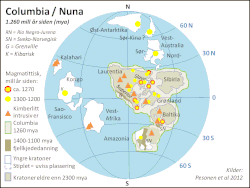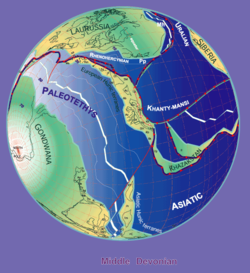Top Qs
Timeline
Chat
Perspective
North Andes plate
Small tectonic plate in the northern Andes From Wikipedia, the free encyclopedia
Remove ads
The North Andes plate or North Andes block is a small tectonic plate (microplate) located in the northern Andes. It is squeezed between the faster moving South American plate and the Nazca plate to the southwest. Due to the subduction of the Coiba and Malpelo plates, this area is very prone to volcanic and seismic activity, with many historical earthquakes.
Remove ads
Boundaries
The North Andes plate is bound by (clockwise from north):
- Caribbean plate
- South American plate
- Malpelo plate – considered a part of the Nazca plate before 2017[1]
- Coiba plate – considered a part of the Nazca plate before 2016[2]
- Panama plate
Terranes
Summarize
Perspective

• Tahamí terrane is enclosed by BSF, OCA and RFS
• Anacona, Arqúia and Quebradagrande terranes are emplaced by RFS
• La Guajira terrane is enclosed by BSF and northernmost by Oca
• Caribe terrane is enclosed by BSF, RFS and plate boundaries with Coiba (red) and Malpelo plates (purple)

The Colombian part of the North Andes plate is subdivided into several terranes:[3]
Tectonics
Subduction of the Coiba plate underneath the North Andes plate causes frequent earthquakes in the Bucaramanga Nest, the most seismically active area in the world. The Bucaramanga-Santa Marta Fault stretches along the plate for more than 600 kilometers from north to south. The plate boundary with the South American plate is most tectonically active along a more than 900 kilometer long megaregional fault system; the Eastern Frontal Fault System.
This fault system, extending into Ecuador and Venezuela all along the northern Andes, separates the terranes from the North Andes plate from:[3]
The accreted terranes of the North Andes plate represent a complex geologic history. There have been two instances of intra-oceanic arcs colliding with the continent. The first of these events, which took place ~90-65Ma, involved the subduction of an intra-oceanic arc beneath the South American/North Andes plate. This subduction led to margin-parallel strike slip motion and shortening across the entire region. The second major collision occurred approximately 12Ma, during the Miocene. This event involved closing a ~1200 km-wide middle Eocene seaway and docking the Panama arc with South America. This second collision event also accelerated strike-slip faulting along the North Andes margin. Reconstruction studies of the area illustrate the complex dynamics of the tectonically active North Andes plate margin.[16]
Remove ads
References
Further reading
Wikiwand - on
Seamless Wikipedia browsing. On steroids.
Remove ads





